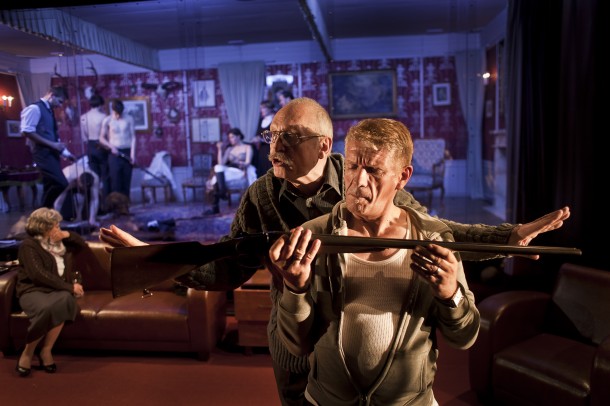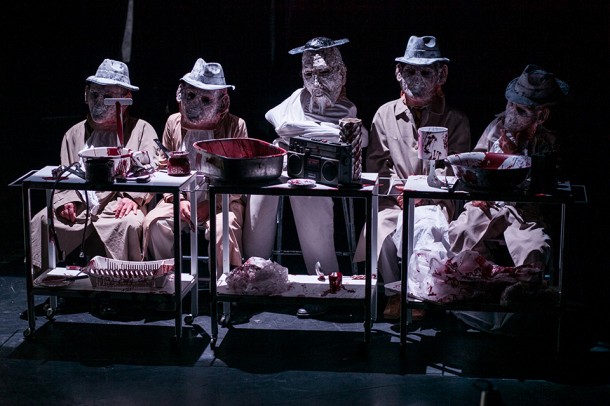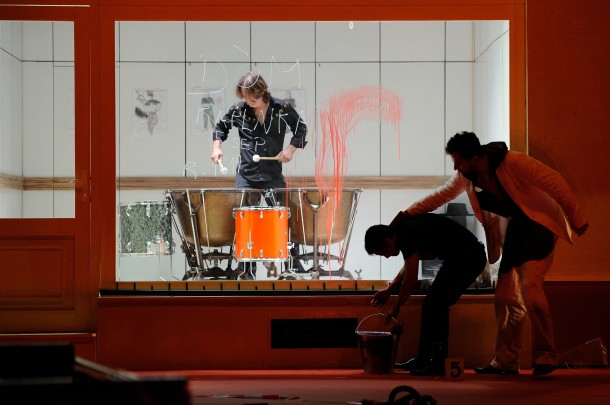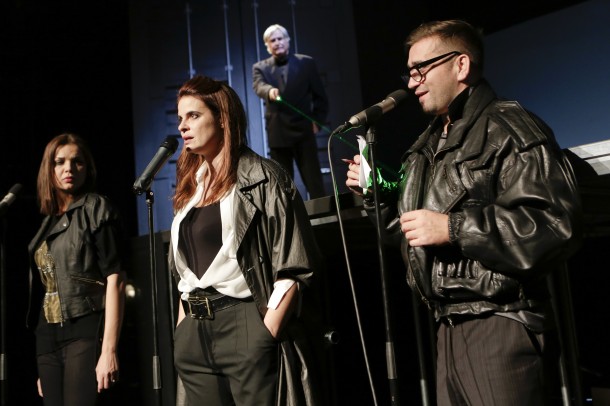Before the performance begins, the actors playing major characters enjoy informal pre-party conversations and drinks standing at the front of the stage or sitting there in a sofa and armchairs. On a small table there are glasses, bottles, and plates with cakes. Musicians prepare their instruments for playing their classic quartet. Weak light illuminates both the stage and the auditorium suggesting one, single space. In the back, behind a see-through curtain, we can notice another space which represents the entrance hall to countess Batthányi’s Rechnitz Castle. Inside, in the dark or in the dimlight, stand young men and women with their faces illuminated with pin-points of light, wearing black suits, white shirts, and dresses—these are presumably the guests and servants at the countess’s last party before the next day’s fight with the Russians coming to conquer this part of the Third Empire, the Burgenland in Austria. There is a tense, mysterious atmosphere. The performance begins with the appearance of a young woman, a symbolic presence of the Hungarian Jews in Rechnitz, a small Austrian town near the Hungarian border, who work there as forced laborers. Silent, selected as unable to work, the Jews are too exhausted and hopeless to defend themselves against brutality and violence. The girl, with clearly semitic features (the actress is of Jewish origin which brings in the local Slovak connotations from WWII and the fascist so-called Slovak State), recites from T. S. Eliot’s poem “The Hollow Men.” The guests downstage listen with polite interest as if taking part in a cultural program that runs parallel to the theatre event. But very soon, we as spectators realize that something dark and cruel underlies these verses devoted to the theme of death.
Elfriede Jelinek’s play Rechnitz (The Exterminating Angel/Der Würgeengel) is based on a real event which happened shortly before the end of the Second World War, known as Rechnitz massacre. Countess Batthányi—a member of the famous Thyssens family loyal to Hitler (she got her Hungarian name from her husband)—invited local Nazi political and army representatives to a party which turned to a bloodshed when drunken guests shot almost two hundred Hungarian Jews imprisoned in a nearby barn. First, the Jews had to undress and then, naked, dug graves for themselves. The event itself is not depicted directly; we get to know it mainly from messengers—servants. In accord with Jelinek´s elaborated style, her play is a metatext—it has elements of a Greek tragedy, inspired by Euripides’ Bacchae and the famous film by Luis Buñuel. Jelinek’s play is fragmented in a postmodern way as a jigsaw puzzle that we have to put together ourselves as spectators or readers. The characters speak about art and how it can or cannot be understood by ordinary people, but also about their favorite rifles, creating a high dramatic tension. In their dialogues, they cite from a documentary titled Totschweigen (1994), another strong inspiration for the play, a film in which the authors tried to illuminate the dark history of the Rechnitz tragedy with the help of eyewitnesses. But local people, as well as the nation itself, as Jelinek points out, mostly do not want to recall bad memories; they pretend that everything is forgotten. There have been serious and repeated attempts, unsuccessful so far, to find the remains of the Jews (although according to some sources eighteen bodies have been found.) The guests who shot the Jews come back and continue the party—the show must go on as if nothing has happened. The performance raises the question if there is any real impact of art on our lives as we as spectators return to our homes and to our everyday problems.

Elfriede Jelinek´s Rechnitz (The Exterminating Angel), directed by David Jařab. Slovak National Theatre. Photo: Andrej Balco.
The production directed by David Jařab (known from his works at HaDivadlo in Brno and at Divadlo Komedie in Prague) has created a magic aura, a hypnotic atmosphere and tempo, based on a strange combination of brutal violence and sad poetry, a shocking tragic reality framed in a strongly aesthetic and artistic way. This impression is boosted by very convincing acting by Emília Vášáryová, František Kovár, Szidi Tobias and Richard Stanke, (no characters’ names are mentioned next to the actors’ names in the production program). The actors identify with the historical figures, also the negative ones, and thus symbolically take the responsibility for the tragedy. The actors, too, make the spectators feel as if they participated in the Rechnitz Castle party, silently witnessing the whole story. The performance is thus very provoking and agitating. The silence, let’s say the citizens’ silence in a political sense, is a very topical issue in the Slovak society, lethargic to contemporary politics and massive corruption. The Slovak society, similarly to the Austrian one, tends to forget national history very quickly, especially its problematic parts.
Besides sensitive directing and acting, it is the congenial double space setting, theatrically very effective and impressive, created by the director himself, that plays a key role in the success of the production. Elfriede Jelinek’s Rechnitz (The Exterminating Angel)staged at the Slovak National Theatre, got the Grand Prix at the Nová dráma (New Drama) festival held this year between May 12th and 17th in the Slovak capital Bratislava.
The festival is celebrating its tenth anniversary and offers a rich program, both of productions in the competition and of accompanying events. It focuses on the Slovak and contemporary drama staged at the theatres in Slovakia. It has also a special foreign section, this year devoted to the Hungarian theatre. The productions selected by the festival board have a common theme: a return to history, a national or a personal one, its interpretations, parallels with the contemporary reality, its consequences for and its influence on our present lives. Several productions use real historical materials on stage, visual or audio recordings, so partly they are docudramas.
The second awarded production, which received The Jury Honorary Acknowledgement, returns to the beginning of the 17th century. Evidence of Blood (Svedectvo krvi) is a historical play by the well-known Slovak dramatist Karol Horák. The real story of the three Jesuit missionaries who came to Košice, the present metropolis of the Eastern Slovakia, to re-Catholicize the predominantly Protestant town, is viewed from the perspective of their headsman. Their torture and death is interpreted as a contemporary story of intolerance. (Tough it is difficult to generalize, the missionaries have some Arabic features and they look like partly Roma people, and the music sometimes has a clear oriental character.) The young Polish director Agnieszka Olsten de-emphasized the historicity of the play and stressed the general idea of intolerance and violence deeply rooted in human mentality. Her conception of a total theatre with dance and music radically reduces the playwright´s text and characters, but at the same time enriches the stage experience. She brings to the Štátne divadlo (The State Theatre) Košice, an innovative way of staging, characteristic for Polish theatre. We can see young actors enjoying this concept and fully engaging in the production transferring its vibrant energy to the spectators. In the musical-theatre-of-movement stylized performance every actor can show his or her natural talents. Besides the historical characters the actors play themselves too. Catholic missionaries and the Protestant headsman (very convincingly played by Andrej Palko) exchange their religious opinions quite matter-of-factly; the missionaries especially are calm and quiet as they express their emotions through singing and playing music. The brilliant, stunning Peter Orgován’s (the martyr Pongrac) playing solo on his violin is an unforgettable theatre experience, an effect you cannot articulate in words. In his solo he expresses his strong religious belief but also his faith in and his celebration of life; just a moment later the headsman ritually cuts the martyr’s throat. The headsman himself reminds us partly of a bad boy-rapper in his characteristic t-shirt with a cape, and partly of a violent Mafioso or a former soldier who performs his bloody work with an open pleasure.
The setting by Tom Ciller, already a well-known and respected artist, the son of the famous set designer Jozef Ciller, is very effective and spectacular. The stage is divided into several horizontal planes: the front stage—with a piano and a piano player on the left and three standing microphones and loudspeakers on the right, the main stage—wide enough for all the dance and stylized movement, and the backstage—a kind of a music studio with kettle-drums. We see the signs painted in red on the glass wall—the blood of the executed victims. An original directorial concept consisting in high-energy acting and an elaborate, ingenious set design create a strong performance that captures all spectators’ senses.
Carpathian Thriller by Eugen Gindl is another example of a docudrama. It is based on a real scandal known as “the Gorilla Case” involving major Slovak financial groups. During the nineties a global company developed a sophisticated way of bribing its members with commissions to win state offers and consequently to sell highly overpriced equipment to hospitals. This real story serves today mainly as a symbol of huge corruption in government and politics. Though the play is very topical and has somewhat journalistic elements, the director Roman Polák makes it timeless and theatrical due to the playful performance. We follow a story of a journalist covering the case; some people from the media help her, some betray her; people from the company try to bribe or threaten her. The performance has strong anti-illusionist elements and several actors play more than one character; there is a Harlequin from commedia dell´arte (the Chairman of the company), the gravedigger from Hamlet (a real gravedigger connected to mafia groups providing him with the corpses, or only heads and bodies, of the people they killed, as he puts it), and a deus ex machina returning several times in different reincarnations. The setting by Andrej Ďurík is divided into two main parts: the visible and the less visible. The visible consists of the main stage where the core of the story takes place; it is a bit higher than a normal stage, in order to also show the criminal underground. The less visible, lower space, is the world of the gravedigger and his bizarre cemetery where we can see rather well the dead-body parts scattered all around among paper boxes and other debris.
The political story is intertwined with a personal one: the journalist Zuna lives together with her friend and lover Nadja, who in the past was forced into prostitution. Both women seem to be disappointed by the world of men, full of violence and corruption. The performance reaches its strongest moments in the scene of a manipulated press conference revealing the case, when the spectators become a part of the invited media audience and the actors speak directly to us. For me the greatest impression was the very end of the production: actors together pray loudly to financial groups, asking them to steal with moderation, otherwise “we’ll rise up, take stones, metal bars and knives, we’ll dismantle your walls, kill your wives and children, so their blood will splatter on your Mercedes cars, we’ll break glass of your offices and there will be chaos, cruelty and anger everywhere.” You can imagine the consternation in business and political circles by this piece staged at the Slovak National Theatre, performed by some of the most popular and the best Slovak actors such as Zuzana Fialová as Zuna, Dušan Jamrich as the head of the company, or Leopold Haverl as the Hamletian gravedigger. One representative of a financial group even protested on his Facebook, objecting to the ending of the production, but you would not like to read comments responding to him. It only proves how deeply people mistrust politics and how strongly they believe that politicians and officials are corrupted by business interests, that decide about all the important issues, including foreign policy. The legally justified system of bribing when the money goes to a political party only frustrates the ordinary people who do not know who to vote for. So far, there has been not a single Slovak politician on trial and imprisoned for the “Gorilla Case.” During the scandal when a report of secret criminal police describing in detail the system of corruption was published in newspapers, there were mass demonstrations; however, at that time the event had already been manipulated by the politicians and it was difficult for the organizers to formulate their goals. Eugen Gindl’s play targets precisely this problem. Cleaning up public affairs and politics will be one of the main tasks for the Slovak society in the recent future.
Aquabelles by the Czech dramatist David Drábek focuses more on contemporary human relations. This comedy, or better, tragicomedy, pictures three friends from different middle-class surroundings. Kajetán is a TV moderator of a reality music show, an extrovert, and a popular figure, presumably rich too. Kajetán is bisexual, having relations with many women, but also with his professor of English. He is more and more exhausted by the life in show business and by his superficial relation with his present girlfriend, a simple, beautiful and very pragmatic Edita. Pavel, a university professor has existential problems, little money, and a sense of being a loser; he is dissatisfied with himself and everything around him. He often expresses his frustrations within his family and his unhappy wife wants to leave him. Pavel usually accuses the Communist past as the main source of his failure. He sees everything as connected to the previous era and corrupted by the Communists’ continuing participation in the present power structures in the country. According to him, every politician is a former agent of the State Secret Service. The ideals of the Velvet Revolution were definitely stolen. The third friend, Filip, is in a strange state of mind; he wants to finish with everything human and wants to become an otter. His friends observe his change with increasing amazement, though they partly understand his effort to escape the real world. Stressed out by contemporary life, all three of them have found peace and compensation in synchronized swimming and only in the pool do they feel really free and relaxed. It is not a surprise that in the end Filip commits suicide by drowning. On this occasion, at least, his two friends are forced to think about real values in life.
Though the motif of Aquabelles seems to be problematic for the theatre, the production of the Slovak Chamber Theatre in Martin (Slovenské komorné divadlo) proves the contrary. The set design, created by Jozef Ciller, one of the most important Slovak theatre professionals, is one of the strongest elements of the production. The construction, resembling a pool with a see-through plastic curtain, on which a blue field of color with bubbles is projected, together with three flexible ropes similar to the system of a big trampoline, produce impressive theatrical images. Some of them are ironic and absurd, such as the scene when, after Filip´s funeral, Kajetán and Pavel carry a big paper box resembling a coffin. They climb the pool walls and with maximum effort pull the coffin on top of the construction just to toss out a small doll into the water. This way, in black suits, they pay respects to their dead friend. Water, as the basic natural element, a symbol of purity, and an element from which the whole life arose, plays a special role in this production.
The sensitive directing of Rastislav Ballek, one of the few directors who can match the talent of Jozef Ciller, is congenial with the Drábek’s play. Ballek’s work is not striking but very concentrated, creative and enriching the text. I can hardly imagine more suitable directing for this kind of a play. The only shortcoming is that the acting is a bit unbalanced: the men are in general more convincing than the women, but, indeed the male characters have much more prominence in the play. While Marek Geišberg plays Kajetán, Dano Heriban performs Pavel, and Dominik Zaprihač appears as Filip, Zuzana Rohoňová portrays Pavel’s wife Markéta.
It is not a surprise that David Drábek won the Alfred Radok prize for this play, as he has been successful several other times in this prestigious competition. Drábek is also known as a director and a dramaturg. He has worked mainly in the Klicpera Theatre in Hradec Králové. His dramas are also produced abroad, however. The play Aquabelles is translated into ten languages and has been published in anthologies of contemporary Czech plays in New York, Buenos Aires, and Moscow.
The Theatre Astorka from Bratislava participated in the festival with The Comet, a new German play by Justine del Corte, a dramatist of Mexican-German origin. She is also known as an actress, film producer and director and was a member of the Berlin Schaubühne and the Hamburger Kammerspiele. She is married to the well-known German playwright Roland Schimmelpfennig whose plays have also been staged in Slovakia. No wonder that the playful Comet won the Prize of Bratislava Spectators. The author calls her play a comedy about ephemerality and illusions: the proclaimed happiness of the characters is just their illusion. At the same time, the relations of the protagonists, though imperfect, are very human. The story unfolds during a hot summer day and night and its festive, carnival-like atmosphere resembles Shakespeare’s Midsummer Night’s Dream. I have to confess I had some prejudices about how a play with eleven equally important characters could work, but it did, similarly to Brecht’s Wedding or Tracy Letts’s August: Osage County, to cite a more recent example.
The plot is somewhat bizarre: Elisabeth, a young woman, wants to celebrate her tenth wedding anniversary by the exact reconstruction of that event, with exact people, exact speeches and clothes. Of course, this is not possible and during the night the old loves and relations re-emerge only to prove how our emotions and happiness are unstable. Elisabeth herself is attracted to her former lover, Gregor (a writer), while her husband Arthur, a transplant surgeon, plays games with several women including Elisabeth’s sister Vera. Gradually, we learn more and more about the protagonists and their past to finally obtain an amusing, witty, but a bit absurd picture of men-women relationships. The charming set and costume design by Mona Hafsahl helps the director Juraj Nvota to create a pleasant, suggestive atmosphere, suitable for the Comet’s playful humor which covers up the protagonists’ effort to find real love and fulfill the emptiness in their lives. Even the comet, which appears for a moment, cannot help to make their wishes come true. The strongest point of the production is its high quality, balanced ensemble acting, (for which Theatre Astorka is well-known), with some extraordinary achievements—especially of Marta Sládečková, as Anna, a well-known film actress; Zuzana Kronerová, as Greta, a less known theatre actress; or Zita Furková as Nane, a businesswoman, to name only a few. But, all actors deserve credit for their creative and concentrated work and the dramatist for her actor-friendly play.
Though other productions selected for the competition did not reach the theatrical complexity and impact of the ones described above, I found many interesting elements in each of them. They brought serious themes, as well as satirical and ironical interpretations of certain national myths, especially in The Land of Unscythed Meadows by Mikuláš Hoblina Šahanský (staged at the Pôtoň Theatre in Bátovce), or a theme of superficial sexual relations of contemporary young people still searching for their own identities (Single Radicals by Michaela Zakuťanská, staged at the Prešov National Theatre). Others explored a kind of “cool” drama with promising acting and with “cool” language influenced by Mark Ravenhill’s work, (there is also an affinity of David Drábek’s Aquabelles to Ravenhill’s, Kane’s, Letts’s, Srbljanovič’s, or Vyrypajev’s plays). Still others focused on the themes of a difficult life in Slovakia and emigration (Nostalgy by Iveta Horváthová staged at the Bábkové divadlo Na rázcestí/Puppet Theatre On the Crossroads in Banská Bystrica) with a very creative set design by Pavol Andraško.
Still other productions delved into the theme of an unpunished guilt and the influence of dirty secrets and betrayals from the past on the present life (Interior of the Interior by Ľubo Burgr and Dušan Vicen staged by the Theatre SkRAT in Bratislava). This production deserves special mention for its combination of strong theatricality with real facts based on documents from the socialist Ministry of Interior and the State Security Department. They relate to the case of a secret priest and double agent Přemysl Coufal, most likely tortured and killed by the State Security agents. The interesting and alarming fact is that the case was determined to be a suicide and as such was closed and never opened again. Whoever tried to attract attention to this case got into trouble. The last victim was a journalist, who wrote about the case in the daily Pravda in 1993. Ironically, he finished his last article with the sentence: “I am not going to commit suicide.” Several weeks later he disappeared in the High Tatra Mountains and was never found. Maybe, this inspired the production’s ending: the actors leave the stage engulfed in mist and they do not return for the applause. The production was a part of an international project: Parallel Lives – The 20th Century by Eyes of Secret Police organized in Slovakia by the Festival Divadelná Nitra.

Ľubomír Burgr´s and Dušan Vicen´s Interior of the Interior, directed by Ľubomír Burgr and Dušan Vicen. Photo: Gabriela Zigová.
SkRAT is an alternative theatre, working through a collective method, creating each production during the process of rehearsals. Most of the actors are not professionals, but they have a long career in acting and are very creative. Some of them, such as Ľubo Burgr, also known as a composer, Zuzana Piussi, also a film director, but no longer with the company, Vlado Zboroň and Inge Hrubaničová, also known as a writer and a journalist came from the original, famous Stoka Theatre and were long-time collaborators of Blaho Uhlár, the Stoka legendary founder and director. Several SkRAT’s productions were awarded prizes at the New Drama festival in the past.
After a year spent in New York City where I saw dozens of productions ranging from Robert Wilson’s ballet Snow on the Mesa or The Emperor Jones and The Hairy Ape by the Wooster Group through excellent student productions in parks or lofts to quite amateurish productions in small theatres in cellars or a former barbershop, I have to state that the festival New Drama was a pleasant surprise for me. Well organized by the Theatre Institute in Bratislava, with a great variety of accompanying events, fifty foreign guests and journalists, it presented good quality productions proving that the Slovak theatre after an interim period during the nineties has been able to find new themes reflecting a new social and political situation. And the good news is that this has been achieved thanks to the contemporary, Slovak plays.
works and lives in Bratislava, Slovakia. He published reviews and articles in various magazines and anthologies focused mainly on Slovak and American drama. He teaches American drama and theatre in the Theatre Department of the Academy of Performing Arts in Bratislava. As a Fulbright scholar he spent one year in New York City at the Graduate Center of CUNY. He also writes fiction and translates theatre plays from English. He is the editor of the Slovak collections Sam Shepard: Hry (Plays) and David Mamet: Hry published by the Theatre Institute in Bratislava. The University of Konstantin Philosopher in Nitra published his monograph A Long Day Translations´ Journey into Night, devoted to drama translation.





